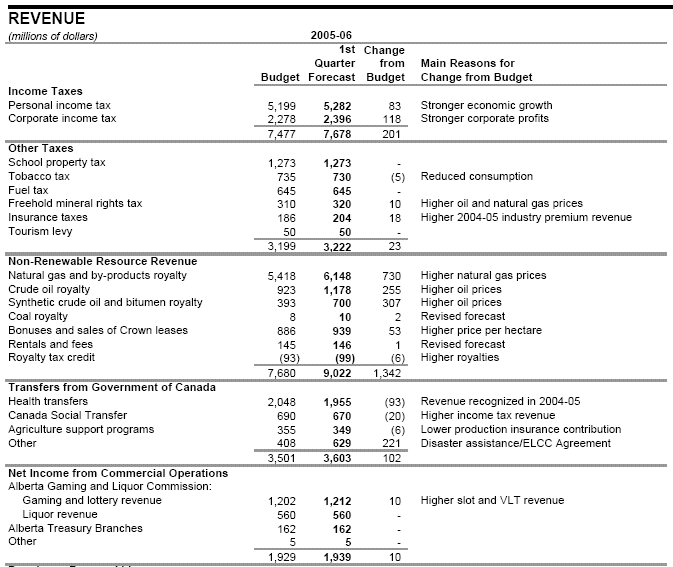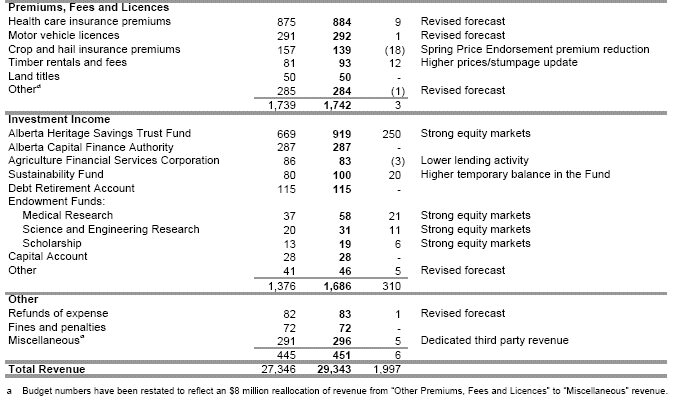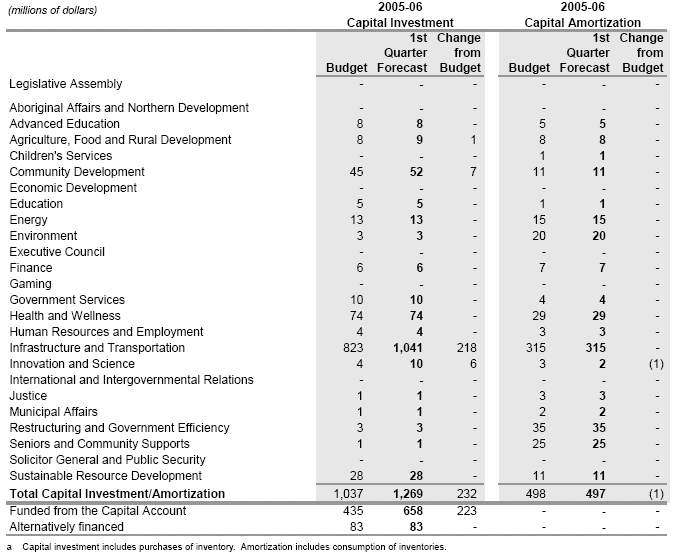2005-06 Quarterly Budget Report:
First
Quarter Fiscal
Update
Released: August
29, 2005
Table of Contents
The First Quarter Fiscal Update consists
of two parts – the updated 2005-06 forecast and the actual
results for the first three months of the fiscal year (April 1 to
June 30, 2005).
2005-06
Forecast
Highlights
-
Energy
prices reached record highs in August. They are considerably
higher than expected by most energy analysts or estimated in
the budget.
-
Energy
price assumptions for the fiscal year have been increased to
US$50 per barrel for oil and Cdn$6.01 per gigajoule for natural
gas. Current market conditions suggest there is still considerable
upside potential to these revised assumptions.
- Based on
the revised energy price assumptions, total revenue is forecast
to be $2 billion higher than estimated in the budget. Partly offsetting
this is a $760 million increase in total expense, including:
-
$516 million increase in capital grants funded from the Capital
Account. This includes funding for schools, post-secondary
facilities, Water for Life projects, affordable housing and
a $100 million contingency for small capital projects.
- $226
million increase in disaster/emergency assistance, primarily
for forest fires and floods.
- $18
million net increase in other expense.
- Capital investment
in government-owned projects, primarily for provincial highways,
has been increased by $232 million. In total, 2005-06 Capital
Plan spending (capital grants plus capital investment) is forecast
to reach nearly $4 billion.
- Net Revenue
(revenue less expense, prior to Sustainability Fund and Capital
Account transfers) is forecast at $2.8 billion. This is $1.2 billion
higher than estimated in the budget.
- The $2.8
billion surplus is primarily allocated to the Capital Account
to help pay for the cost of capital projects in future years,
and to the Heritage Fund and other endowments. The Sustainability
Fund balance is currently forecast to remain at the budgeted $2.5
billion level.
|

| 
Revenue
Non-Renewable
Resource Revenue
Energy prices are much
higher than energy analysts expected at the time the budget was
prepared. The higher prices are due to a growing world demand for
crude oil, the fear of supply disruptions and the absence of spare
production capacity to offset any disruptions. Year-to-date (April
to August), oil prices have averaged US$56.67 per barrel and natural
gas prices have averaged Cdn$6.71 per gigajoule.
Non-renewable resource
revenue is forecast at $9 billion, an increase of $1.3 billion from
the budget estimate. The increase is based on oil prices averaging
US$50.00 per barrel over the fiscal year, an $8.00 increase over
the budget estimate. Natural gas prices are assumed to average Cdn$6.01
per gigajoule, an increase of 41 cents from the budget estimate.
Total oil royalties are
forecast at $1.9 billion, $562 million higher than estimated in
the budget while natural gas royalties are forecast at $6.1 billion,
up $730 million from budget. Other non-renewable resource revenue
is forecast at $1 billion, $50 million higher than budget.
The Fiscal Responsibility
Act requires that non-renewable resource revenue above $4.75
billion be transferred to the Sustainability Fund. This transfer
is now forecast to be $4.3 billion.
Tax
Revenue
Personal income tax revenue is $83 million higher
than estimated in the budget and corporate income tax revenue is
$118 million higher. This reflects stronger-than-expected economic
activity resulting primarily from higher energy prices.
Other tax revenue is forecast at $3.2 billion, $23
million higher than estimated in the budget. The increase reflects
higher revenue from the freehold mineral rights tax and insurance
taxes partially offset by lower tobacco tax revenue.
Transfers
from Government of Canada
Transfers from the Government
of Canada are $102 million higher than budgeted. The increase consists
of:
- $122 million for flood disaster
assistance.
- $70 million for the Early Learning
and Child Care Agreement (ELCC). The specific allocation of these
funds has not yet been determined and no related expense increases
have been included in this update.
- $19 million for the New Deal for
Cities and Communities and other infrastructure.
- $9.5 million for Phase II of the
Canada/Alberta Affordable Housing Agreement.
- $93 million decrease in health transfers,
of which $62 million is due to some of the allocation for the
Wait Times Reduction Fund being recognized in 2004-05 rather than
in 2005-06, and $31 million is a result of higher income tax revenue.
- $20 million decrease in Canada Social
Transfer due to higher income tax revenue.
- $6 million reduction in federal
agriculture transfers for crop and hail insurance.
Investment
Income
Investment income is forecast
at $1.7 billion, $310 million higher than estimated in the budget.
This increase is due mainly to stronger-than-expected equity market
performance. The increase consists of:
- $250 million in Heritage Fund income.
- $38 million increase in endowment
fund income.
- $20 million increase in Sustainability
Fund income, due to higher temporary balances in the Fund.
- $2 million net increase in other
investment income.
Other
Revenue
Other revenue is $19 million
higher than budgeted. The increase comprises:
- $10 million increase in gaming
revenue related to higher slot and video lottery terminal revenue.
- $12 million net increase in timber
rentals and fees due to higher-than-expected market prices for
solid wood products and a revenue reduction from updating Alberta’s
Softwood Stumpage System, effective January 1, 2006. This update
reduces 2005-06 revenue by $6 million, which is charged to the
Contingency Allowance.
- $9 million increase in health care
insurance premiums revenue.
- $18 million decrease in crop and
hail insurance premiums due to a $10 million reduction in Spring
Price Endorsement premiums, charged to the Contingency Allowance,
and to lower commodity prices and participation rates.
- $6 million net increase in other
revenue.
|


| 
Expense
Total expense is $760 million higher
than the budget estimate. Changes include:
- $516 million for increased capital
grants from the Capital Account.
- $226 million for increased emergency/disaster
assistance from the Sustainability Fund.
- $30 million net increase in dedicated
revenue/expense.
- $3 million net increase for in-year
initiatives drawn against the Contingency Allowance.
- A $15 million decrease in debt servicing
costs.
Sustainability
Fund
Disaster/Emergency Assistance – $359 million
is being provided, including:
- $151 million for flood
disaster assistance, partially offset by $122 million in federal
transfers.
- $148 million for Bovine
Spongiform Encephalopathy (BSE) assistance, an increase of $15
million from budget, partially offset by $34 million in federal
transfers.
- $57 million for forest
fire-fighting costs.
- $3 million for detection
and control of mountain pine beetle infestations.
The costs of flood assistance,
forest fires and mountain pine beetle infestations are to be funded
through the Sustainability Fund, pending declaration of disasters
and emergencies under the Fiscal Responsibility Act.
Natural Gas Rebates
– $285 million in rebates are forecast to be paid,
unchanged from the budget estimate. Winter rebates are paid during
the November to March period. This forecast is based on the first
tier trigger price ($5.51 to $7.50 per gigajoule) being reached
in all five eligible months. The first tier provides a $1.50 per
gigajoule rebate.
Capital
Account
Capital grants funded from the Capital Account have been increased
by $516 million: $352 million for schools and post-secondary capital
projects; $100 million for a contingency for small capital projects;
$54 million for the Water for Life strategy; $9.5 million
for Alberta’s contribution under the Canada/Alberta Affordable
Housing Agreement.
Funding
From the Contingency Allowance
$248 million was set aside in the budget for in-year, non-emergency
initiatives. In-year initiatives include a $24 million increase
for school operations and maintenance and $19 million for increased
Revenue Insurance Coverage co-payments. These expenses are partly
offset by $36 million in lapses in various ministries and a net
of $4 million in transfers from operating expense to capital investment.
$16 million in in-year revenue reduction initiatives have also been
charged against the Contingency Allowance. There is $229 million
remaining in the Contingency Allowance.
Ministry
Changes
Agriculture, Food
and Rural Development –$10 million net increase from
budget This includes a $15 million increase for BSE-related initiatives,
a $19 million increase in Revenue Insurance Coverage co-payments
and a $5 million increase in dedicated revenue/expense. Offsetting
this is a $28 million decrease in crop insurance and other lapses
and a $1 million transfer from operating expense to capital investment.
Education
– $24 million increase for school operations and maintenance.
Infrastructure
and Transportation– $527 million increase from budget.
This includes $207 million for school capital projects, $145 million
for post-secondary facilities, $100 million for a contingency for
small capital projects, $54 million for projects in the Water
for Life strategy and $21 million in dedicated revenue/expense
increases for the New Deal for Cities and Communities and for the
Calgary Children's Hospital interchange.
Municipal Affairs
– $151 million increase for flood disaster assistance. The
increase relates to the 2005 Southern Alberta Disaster Recovery
Program, which is partly offset by a $122 million increase in federal
transfers, and the 2005 Lesser Slave River Disaster Recovery Program.
Seniors and Community
Supports – $19 million increase for Phase II of the
Canada/Alberta Affordable Housing Agreement, which is partly offset
by a $9.5 million increase in federal transfers.
Sustainable Resource
Development – $60 million increase, consisting of
$57 million for higher forest fire-fighting costs and $3 million
to detect and control mountain pine beetle infestations.
Debt
Servicing Costs
Debt servicing costs have decreased $15 million from budget due
to lower borrowings and lower interest rates. |



Alberta
Sustainability Fund
Assets
of the Sustainability Fund
Sufficient assets will be maintained
in the Fund to offset the cost of emergencies, disasters and natural
gas rebates in 2005-06 and maintain the Fund at the $2.5 billion
level. Assets above this level have been allocated to:
- The Capital Account to help pay
for capital projects in 2005-06 and future years.
- The Heritage Fund and endowment
funds.
Sustainability
Fund Transfers
Total net transfers to the Sustainability
Fund are forecast at $4.3 billion. This includes:
- Non-renewable resource revenue
– The Fiscal Responsibility Act requires resource
revenue in excess of $4.75 billion to be transferred to the Fund.
- Withdrawals – Transfers from
the Fund are permitted to pay for costs of emergencies, disasters
and natural gas rebates.
- Other net transfers – Includes
revenue increases (excluding resource revenue, revenue reductions
charged to the Contingency Allowance, and dedicated revenue/expense
changes) and the reduction in debt servicing costs.
Adjustments
The net transfer to the Fund is adjusted
for:
- Retained income of funds and agencies
– primarily Alberta Treasury Branches.
- Capital cash requirements for capital
investment – partly met through a transfer from the Capital
Account.
- Differences of when cash is accrued
and received, non-cash expenses/revenue, and when cash is transferred
to the Fund. These primarily relate to energy revenue and finalization
of year-end results.
Allocation
Approximately $6 billion is available
for allocation in 2005-06. This includes the $1 billion available
as of March 31, 2005 and $696 million from the final year-end results
for 2004-05 (transferred to the Fund in 2005-06). The $6 billion
has been allocated as follows:
- $926 million to the Heritage Fund
and other endowment funds.
- $5.1 billion to the Capital Account
to help pay for capital projects in 2005-06 and future years.
Nearly $2.5 billion is being used in 2005-06 for capital grants
and capital investment and $2.6 billion is being held in the Capital
Account for capital costs in future years.

|
| 
Capital
Plan
-
Capital asset acquisitions
(capital grants to local authorities and capital investment
in provincial government-owned projects) are forecast to increase
by $788 million from budget to almost $4 billion. Most of the
increase is being funded through the Capital Account from higher-than-forecast
2004-05 fourth quarter results and increased 2005-06 revenue.
-
Municipal
Infrastructure Support – Total allocation of
$1.1 billion, an increase of $71 million from budget. This includes
$54 million for Water for Life projects and $17 million for
the New Deal for Cities and Communities.
-
Provincial
Highway Network – Total allocation of $851 million,
an increase of $167 million from budget. This increase consists
of $100 million to accelerate projects in resource development
regions, $30 million for the 2005-06 allocation of the $200
million announced to accelerate construction in the Fort McMurray
area, and $37 million in other increases and the carry-over
of funding for unfinished 2004-05 projects.
-
Schools
– A total allocation of $431 million, an increase of $230
million from budget for various school projects and for portables
and portable moves.
-
Post-Secondary
Facilities – Total allocation of $256 million.
This is a $145 million increase from budget.
-
Government
Facilities, Housing and Equipment – Total allocation
of $420 million, an increase of $66 million from budget. This
includes funding for Phase II of the Canada/Alberta Affordable
Housing Agreement, the carry-over of funding for unfinished
2004-05 projects and other increases.
-
Other Infrastructure
Programs – Total allocation of $904 million,
an increase of $109 million from budget. This includes
- Capital
Contingency – $100 million for a contingency
for small capital projects.
- Other
– $9 million increase from budget for the Canmore Nordic
Centre Facility and water and wastewater connections for slaughter
facilities.

|
|

Net
Financial and Capital Assets
-
Net Assets
– Net assets are forecast at $28.7 billion as
at March 31, 2006. This includes capital assets of $11.7 billion.
-
Accumulated
Debt/Debt Retirement Account – The Fiscal Responsibility
Act requires assets in the Debt Retirement Account to be equal
to or greater than the remaining unmatured accumulated debt.
-
Capital Account
– The Capital Account is forecast at $3.3 billion, a $1.1
billion increase from budget.
-
Heritage Fund
– The book value of the Heritage Fund (value
of external investments) is forecast at $11.8 billion, an increase
of $484 million from March 31, 2005. The increase includes allocations
for the Advanced Education endowment and inflation proofing,
and changes to internal holdings of provincial corporation debt.

|

Capital
Account


Assets,
Liabilities and Net Assets


Net
Financing Requirements


Fiscal
Year Assumptions


Capital
Investment and Amortizationa


Capital
Grants to Local Authorities and Other Infrastructure Supporta


|
Actual Results
For
the first three months of 2005-06
Method
of Consolidation
This financial summary is prepared
on the same basis as used in Budget 2005.
The results of all government departments,
funds and agencies, except those designated as commercial enterprises,
are consolidated on a line-by-line basis. Revenue and expense transactions
between consolidated entities have been eliminated.
The accounts of Crown-controlled corporations
and provincial agencies designated as commercial enterprises are
consolidated on the modified equity basis, the equity being computed
in accordance with generally accepted accounting principles.
Basis
of Financial Reporting
The consolidated fiscal
summary reports revenue (including gains and losses from sale of
capital assets), expense (including amortization of capital assets),
and net revenue.
Expense includes the province's
annual cash payments towards the unfunded pension obligations. Expense
excludes the annual change in the unfunded pension obligations,
which is a non-cash expense that does not affect borrowing requirements.
Revenue and expense are
recorded using the accrual basis of accounting. Cash received for
goods or services which have not been provided by period end is
recorded as unearned revenue. Debt servicing costs include interest
payable, amortization of discount on debt issues, and amortization
of unrealized exchange gains and losses on unhedged foreign currency
debt.
Comparative 2004-05 figures
have been restated where necessary to conform to the 2005-06 presentation.

|
Consolidated
Fiscal Summarya


Expense

|










